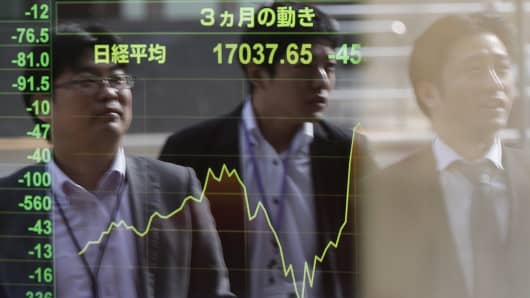Japan's perennially low yields will keep the
country's conservative bond investors lusting after Australia's safe and
stable bonds, analysts said.
"Japanese investment into overseas bond markets like Australia is set to accelerate as the diversification away from low-yielding Japanese Government Bonds (JGBs) continues," said HSBC Head of Global Emerging Market Rates Research Andre de Silva in a note published last week. "All else equal, a sustained appetite for Australian bonds from Japanese investors can lead to up to $63 billion of inflows into Australia over the next two to three years," he said.
Interest rates in Japan have been on a relentless slide for
twenty years, with the benchmark 10-year JGB yielding just 0.388 percent, and Japanese investors, both institutional and retail, are old hands at investing in Australia.
The quest for yield may become more urgent: since the Bank of Japan launched an unprecedented bond purchase program in the spring of 2013, the benchmark 10-year JGB bond yield has fallen from 0.559 percent to touch an all-time low of 0.207 percent this January after a second round of quantitative easing last October.
"Japanese investment into overseas bond markets like Australia is set to accelerate as the diversification away from low-yielding Japanese Government Bonds (JGBs) continues," said HSBC Head of Global Emerging Market Rates Research Andre de Silva in a note published last week. "All else equal, a sustained appetite for Australian bonds from Japanese investors can lead to up to $63 billion of inflows into Australia over the next two to three years," he said.
Interest rates in Japan have been on a relentless slide for
twenty years, with the benchmark 10-year JGB yielding just 0.388 percent, and Japanese investors, both institutional and retail, are old hands at investing in Australia.
The quest for yield may become more urgent: since the Bank of Japan launched an unprecedented bond purchase program in the spring of 2013, the benchmark 10-year JGB bond yield has fallen from 0.559 percent to touch an all-time low of 0.207 percent this January after a second round of quantitative easing last October.
In 2014, Japanese institutional and retails investors
looking abroad for yield bought $44.3 billion of foreign bonds, and 12.6
percent of that went into Australian bonds, mostly Commonwealth
Government Securities (CGS), according to HSBC's de Silva.
The most conservative of Japanese investors like to avoid to taking on any country risk, and that means they prefer investing in developed G8 countries. But, with yields in Europe also sinking to record lows, "the most risk averse among them have been reduced to two choices: Australian and U.S. government bonds," said Nomura's Emerging and Asia Pacific Markets senior strategist Yoshiya Iwata.
It's all relative, love
The yields on 10-year Australian government bonds remain relatively attractive: the CGS is at 2.619 percent, compared with 2.115 percent for U.S. Treasurys, 0.388 percent for JGBs, and 0.393 percent for German bunds.
The difference between Australian and Japanese government bond yields may not be the only driver, however.
Read MoreNegative yield bonds: Here's who's buying
"The yield pick-up is attractive, but, at the moment, Japanese investors seem to be more currency focused," said National Australia Bank's (NAB) Head of Interest Rate Strategy Skye Masters.
In December, the Aussie dollar broke above 100 yen and that triggered some selling of Australian bonds by Japanese investors, according to Masters.
With the Australian dollar currently around the lower-90 yen range, "they now seem to be coming back," she said. The Australian dollar was fetching around 93.33 yen in early morning Asia trade.
Buying Australian bonds is "a win-win, both on currencies and interest rate yield," said Nomura's Iwata.
There will be profits to be taken on buying the Australian dollar, which is expected to appreciate further against the yen; in the meantime, the CGS looks set to continue to yield more than U.S. Treasury's, Iwata pointed out.
By the end of 2016, Nomura forecasts the yen to weaken to 100 yen against the Australian dollar.
The most conservative of Japanese investors like to avoid to taking on any country risk, and that means they prefer investing in developed G8 countries. But, with yields in Europe also sinking to record lows, "the most risk averse among them have been reduced to two choices: Australian and U.S. government bonds," said Nomura's Emerging and Asia Pacific Markets senior strategist Yoshiya Iwata.
It's all relative, love
The yields on 10-year Australian government bonds remain relatively attractive: the CGS is at 2.619 percent, compared with 2.115 percent for U.S. Treasurys, 0.388 percent for JGBs, and 0.393 percent for German bunds.
The difference between Australian and Japanese government bond yields may not be the only driver, however.
Read MoreNegative yield bonds: Here's who's buying
"The yield pick-up is attractive, but, at the moment, Japanese investors seem to be more currency focused," said National Australia Bank's (NAB) Head of Interest Rate Strategy Skye Masters.
In December, the Aussie dollar broke above 100 yen and that triggered some selling of Australian bonds by Japanese investors, according to Masters.
With the Australian dollar currently around the lower-90 yen range, "they now seem to be coming back," she said. The Australian dollar was fetching around 93.33 yen in early morning Asia trade.
Buying Australian bonds is "a win-win, both on currencies and interest rate yield," said Nomura's Iwata.
There will be profits to be taken on buying the Australian dollar, which is expected to appreciate further against the yen; in the meantime, the CGS looks set to continue to yield more than U.S. Treasury's, Iwata pointed out.
By the end of 2016, Nomura forecasts the yen to weaken to 100 yen against the Australian dollar.


No comments:
Post a Comment